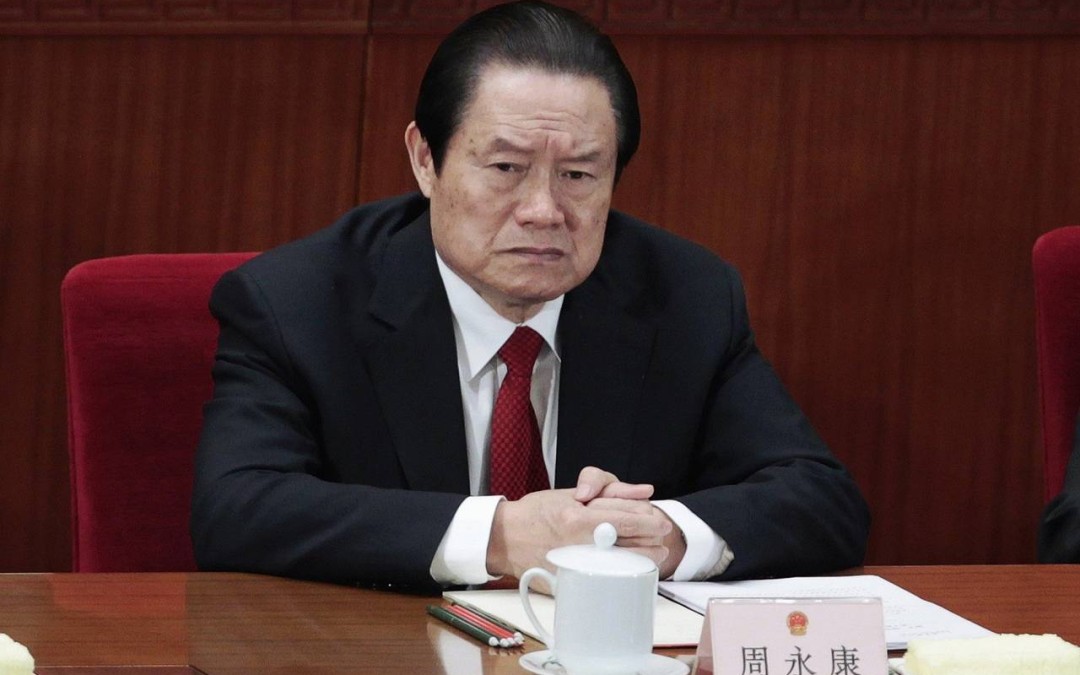Photo from New York Times article "China Anticorruption Drive Moves Toward Next Phase With Zhou Indictment"
Unrest
“Yet another shoe factory revolt: strike of 10,000 suppressed in Zhongshan” translation by Pancho Sanchez of 《广东中山近万工人罢工游行遭镇压》(“Strike + march of nearly 10,000 workers suppressed in Zhongshan, Guangdong”) from Boxun.com, March 23. https://chuangcn.org/2015/03/zhongshan-xinchang-shoe-strike/
An original translation from Chuang, covering another recent strike in a Guangdong shoe factory. From the introduction: “This follows a strike of 50,000 workers at six Yue Yuen shoe factories in Dongguan last April (probably the largest strike at a single company in recent Chinese history), a strike at another Yue Yuen factory in Zhuhai last July, a strike of 2,500 workers at a Lide shoe factory in Guangzhou last December, and a strike of 5,000 workers at Stella shoe factory in Dongguan earlier this month, to name only those we know have made it into the media. (All these strikes have been in Guangdong province, although there are also many shoe factories in other parts of China, especially Wenzhou.)”
“Chinese High School Students Riot Over Mass Food Poisoning” by Radio Free Asia, March 20th, 2015. http://www.rfa.org/english/news/china/students-03202015110932.html
High school students in Guizhou staged sit-ins and then smashed up their campus after hundreds fell sick from being fed out of date food in the canteen. Students also complained of high fees and restrictions placed on their movement: “Enraged by overpriced and poor food, as well as a rule banning the ordering of takeouts, students smashed windows in the controversial on-campus store and the canteen as well as computer equipment in college offices.”
A few more strikes, only in Chinese and not yet translated:
“300 workers strike demanding wage arrears from auto plant in Shanghai” March 30th, 2015. http://wickedonna.blogspot.hk/2015/03/2015330_94.html
“400 steel workers block a road and protest at government building demanding wage and bonus arrears” March 30th, 2015. http://wickedonna.blogspot.jp/2015/03/2015330_31.html
Capital
“Ready to link Silk Road plans with India’s ‘Mausam’: China” by Press Trust of India, April 5th, 2015. http://indianexpress.com/article/india/india-others/ready-to-link-silk-road-plans-with-indias-mausam-china/
On the international stage, China continues to build up its east-west trade networks into Europe. The “maritime” silk road is only one of several components of these new supply chains, which have absorbed enormous amounts of investment and often link up with domestic projects in China’s own far-west.
“China’s Maritime Silk Road Gamble” by William Yale, March 27th, 2015. http://www.eastbysoutheast.com/maritimegamble/
This comes from the excellent blog East by Southeast, and gives a great summary of the “maritime silk road” mentioned by the news story above.
“Hostility From U.S. as China Lures Allies to New Bank” by Jane Perlez, March 19th, 2015. http://www.nytimes.com/2015/03/20/world/asia/hostility-from-us-as-china-lures-allies-to-new-bank.html?_r=2
Another news article detailing the recently launched Asian Infrastructure Investment Bank (AIIB), which is the new, China-led institution funding many of the projects mentioned in the above two articles. This New York Times story details the controversies surrounding the bank, particularly as many countries join the new international institution, raising the ire of the US and potentially challenging more established post-WWII financial institutions like the IMF and World Bank.
“Infrastructure money continues to pour into Kunming” by Patrick Scally, March 23rd, 2015. http://www.gokunming.com/en/blog/item/3449/infrastructure_money_continues_to_pour_into_kunming
On the domestic side, similar investment projects continue apace in China’s far west. The above article portrays Yunnan provincial capital Kunming as awash in investment funds. Kunming now sits as the major overland hub connecting China to Southeast Asia. Projects are in the works to connect it to Bangkok via highway and rail, to Mandalay via a new road system, and, ultimately to the port of Dhaka in Bangladesh. Within this context, numerous officials in Kunming and Yunnan province have also become targets of Xi Jinping’s anti-corruption campaign.
Corruption
“China Anticorruption Drive Moves Toward Next Phase With Zhou Indictment” by James T. Areddy. http://www.wsj.com/articles/china-anticorruption-drive-moves-toward-next-phase-with-zhou-indictment-1428079176
Even while the anti-corruption campaign continues to net smaller officials in cities awash in infrastructure money, it is also beginning to scale up, as Zhou Yongkang, formerly one of China’s highest ranking officials, was finally indicted on charges of bribery and abusing power.
“The anticorruption campaign China’s president has pursued since a transition that included Mr. Zhou’s retirement is unprecedented, in part because it has targeted officials as high ranking as Mr. Zhou, the most senior party member charged with crime since the 1970s.”
“China’s anti-corruption crackdown reaches U.S.” by Sophia Yan, March 27th, 2015. http://money.cnn.com/2015/03/26/news/china-anti-corruption-us/
The anti-corruption campaign is not limited to the Chinese borders, either. Xi’s “Operation Foxhunt” is designed to hunt down corrupt officials who have since fled abroad.
“Beijing believes at least 150 corrupt Chinese officials have fled to America, according to state media, and has sent U.S. authorities a list of the “priority cases” it is targeting.”
“China shutters golf courses, probes officials who play” by Calum MacLeod, April 4th, 2015. http://www.usatoday.com/story/news/world/2015/04/04/china-bans-golf-courses-probes-officials/70770108/
It’s not just corrupt officials under attack, but also their favorite pastimes: “The ruling Communist Party that President Xi Jinping commands has long been nervous of golf’s image in China as an elitist, corrupt pastime. Authorities have taken a tougher stance against a sport that continues to expand in China, attracting U.S. stars to play in multimillion-dollar tournaments and earn millions designing courses. The government has closed almost 70 courses, frozen development nationwide for the past year and started corruption probes into officials who play golf.”


